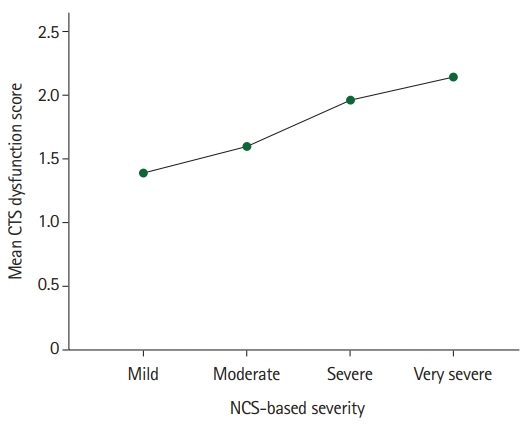Arch Hand Microsurg.
2023 Mar;28(1):16-23. 10.12790/ahm.22.0043.
Carpal tunnel syndrome: correlation of the severity of the clinical picture and electrophysiological studies
- Affiliations
-
- 1Department of Orthopedic Surgery, Royal Medical Services, Amman, Jordan
- 2Department of Neuro-Medicine, Royal Medical Services, Amman, Jordan
- 3Department of Pediatrics, Royal Medical Services, Amman, Jordan
- KMID: 2540026
- DOI: http://doi.org/10.12790/ahm.22.0043
Abstract
- Purpose
This study aimed to correlate the severity of carpal tunnel syndrome (CTS) in terms of the clinical picture with electrophysiological studies to determine whether the severity could be predicted through one measure based on correlations with another.
Methods
This cross-sectional correlational study enrolled 96 patients (139 hands) whose nerve conduction studies (NCS) confirmed the diagnosis of CTS, and to whom the Boston Carpal Tunnel Questionnaire (BCTQ) was administered to determine the subjective and clinical CTS severity. The severity of both measures was correlated.
Results
The patients’ mean age was 49.84±12.23 years. Most (67.7%) were female. The NCS severity grades were as follows: mild, 46%; moderate, 32.4; severe, 9.4%; and very severe, 12.2%. The sensory and motor NCS parameters were significantly correlated with the BCTQ severity. The patients’ overall mean scores for symptom severity had substantive predictive accuracy for the patients’ CTS severity measured with the NCS. Similarly, most of the functional severity score items had significant predictive accuracy for the patients’ NCS-based carpal tunnel severity score.
Conclusion
The clinical severity of CTS was strongly correlated with the severity based on nerve conduction. This correlation was more notable for symptom severity scores than for functional status scores. Night pain and numbness demonstrated the strongest associations of all BCTQ items with the NCS. Although clinical severity (based on the BCTQ) predicts the nerve conduction severity, we still recommend performing NCS for patients with a clinical diagnosis of CTS as a confirmatory objective measure and for medico-legal reasons.
Figure
Reference
-
References
1. Padua L, Coraci D, Erra C, et al. Carpal tunnel syndrome: clinical features, diagnosis, and management. Lancet Neurol. 2016; 15:1273–84.2. Kadow TR, Kaufmann RA, Goitz RJ, Fowler JR. Prevalence of carpal tunnel syndrome in a hand surgeon’s practice. J Hand Microsurg. 2018; 10:79–81.3. Middleton SD, Anakwe RE. Carpal tunnel syndrome. BMJ. 2014; 349:g6437.4. Ntani G, Palmer KT, Linaker C, et al. Symptoms, signs and nerve conduction velocities in patients with suspected carpal tunnel syndrome. BMC Musculoskelet Disord. 2013; 14:242.5. Wipperman J, Goerl K. Carpal tunnel syndrome: diagnosis and management. Am Fam Physician. 2016; 94:993–9.6. Moon PP, Maheshwari D, Sardana V, Bhushan B, Mohan S. Characteristics of nerve conduction studies in carpal tunnel syndrome. Neurol India. 2017; 65:1013–6.7. Sonoo M, Menkes DL, Bland JD, Burke D. Nerve conduction studies and EMG in carpal tunnel syndrome: do they add value? Clin Neurophysiol Pract. 2018; 3:78–88.8. Multanen J, Ylinen J, Karjalainen T, Kautiainen H, Repo JP, Häkkinen A. Reliability and validity of the Finnish version of the Boston Carpal Tunnel Questionnaire among surgically treated carpal tunnel syndrome patients. Scand J Surg. 2020; 109:343–50.9. Hamzeh HH, Alworikat NA. Cross cultural adaptation, reliability and construct validity of the Boston Carpal Tunnel Questionnaire in standard Arabic language. Disabil Rehabil. 2021; 43:430–5.10. Alanazy MH, Alaboudi M, Almaari A, Alhumayyd Z, Albulaihe H, Muayqil T. Translation and validation of the Arabic version of the Boston carpal tunnel syndrome questionnaire. Neurosciences (Riyadh). 2019; 24:296–301.11. Dhong ES, Han SK, Lee BI, Kim WK. Correlation of electrodiagnostic findings with subjective symptoms in carpal tunnel syndrome. Ann Plast Surg. 2000; 45:127–31.12. Izadi S, Kardeh B, Hooshiar SS, Neydavoodi M, Borhani-Haghighi A. Correlation of clinical grading, physical tests and nerve conduction study in carpal tunnel syndrome. Scand J Pain. 2018; 18:345–50.13. Banach M, Gribbin D, Zajaczkowska A. Clinical and electrophysiological correlations concerning patients with carpal tunnel syndrome. Przegl Lek. 2010; 67:692–6.14. De Kleermaeker FG, Meulstee J, Claes F, Kasius KM, Verhagen WI. Treatment outcome in patients with clinically defined carpal tunnel syndrome but normal electrodiagnostic test results: a randomized controlled trial. J Neurol. 2017; 264:2394–400.15. Kortlever JT, Becker SJ, Zhao M, Ring D. Borderline nerve conduction velocities for median neuropathy at the carpal tunnel. J Hand Surg Am. 2020; 45:379–88.e1.
- Full Text Links
- Actions
-
Cited
- CITED
-
- Close
- Share
- Similar articles
-
- Efficiency of the Boston Questionnaire in Carpal Tunnel Syndrome: Comparing Scores with Provocation Tests and Electrophysiological Studies
- Assessment of Severity by High Resolution Ultrasonography in Carpal Tunnel Syndrome
- The Relationship between Clinical and Electrodiagnostic Findings in Carpal Tunnel Syndrome
- Ultrasound-Guided Nerve Hydrodissection for Carpal Tunnel Syndrome
- The Current Concepts for the Pathophysiology of Idiopathic Carpal Tunnel Syndrome



